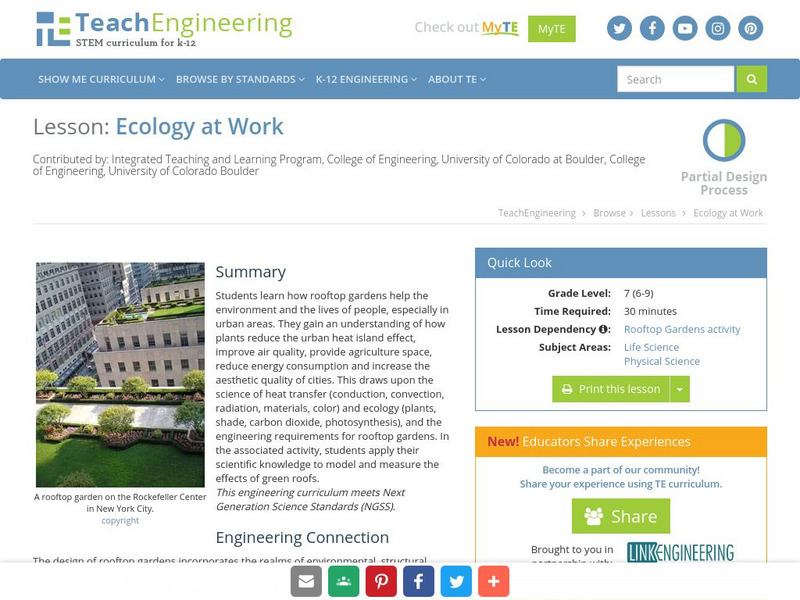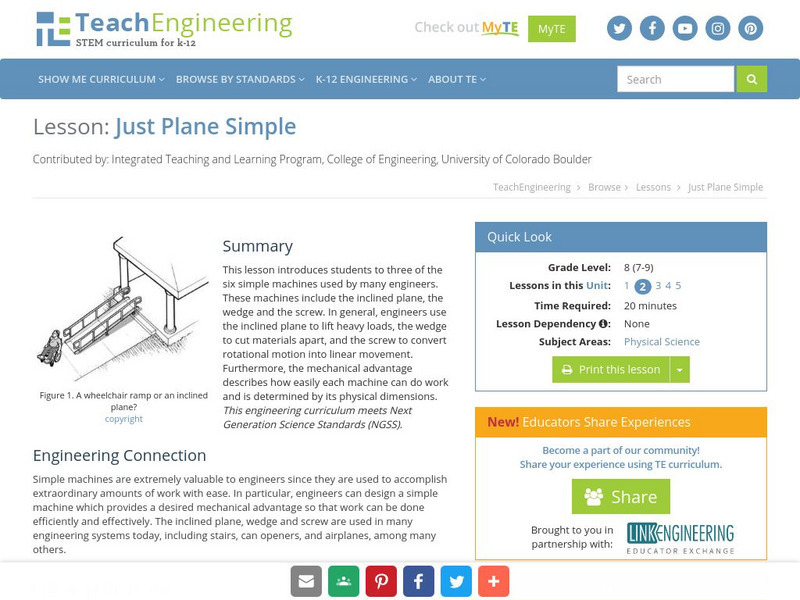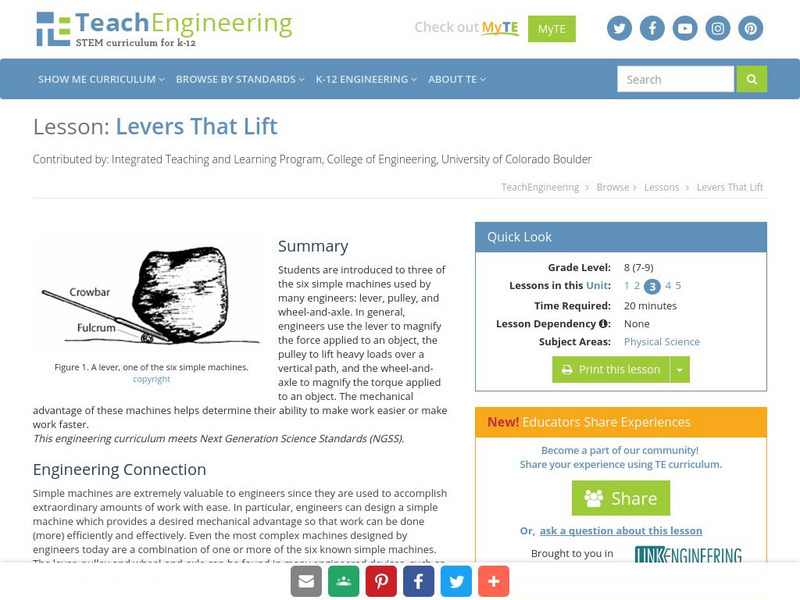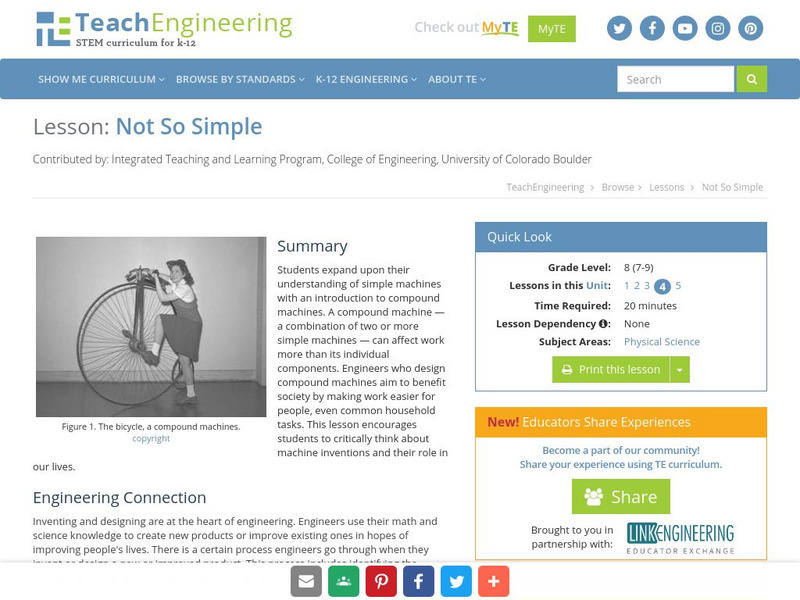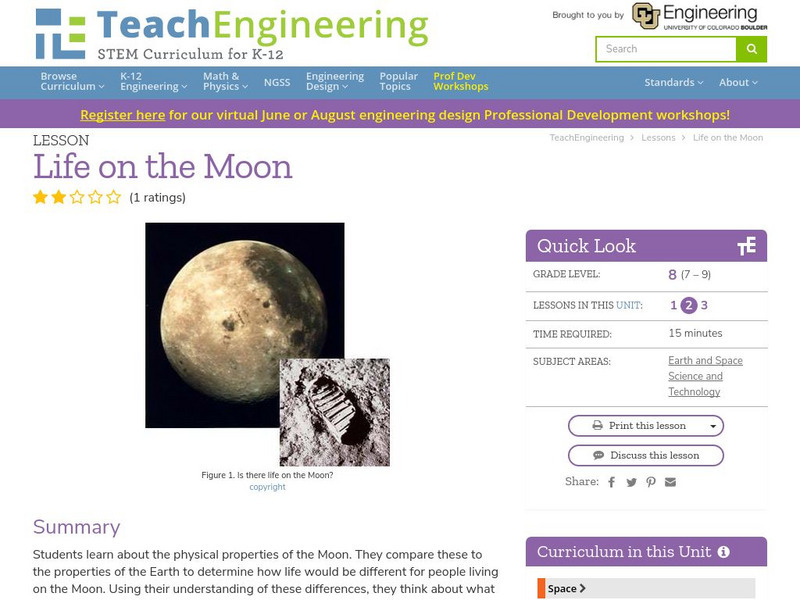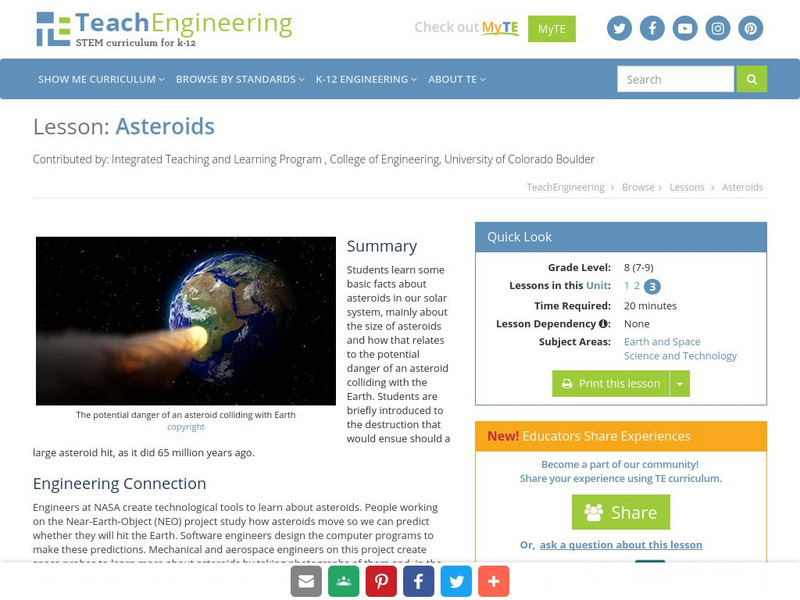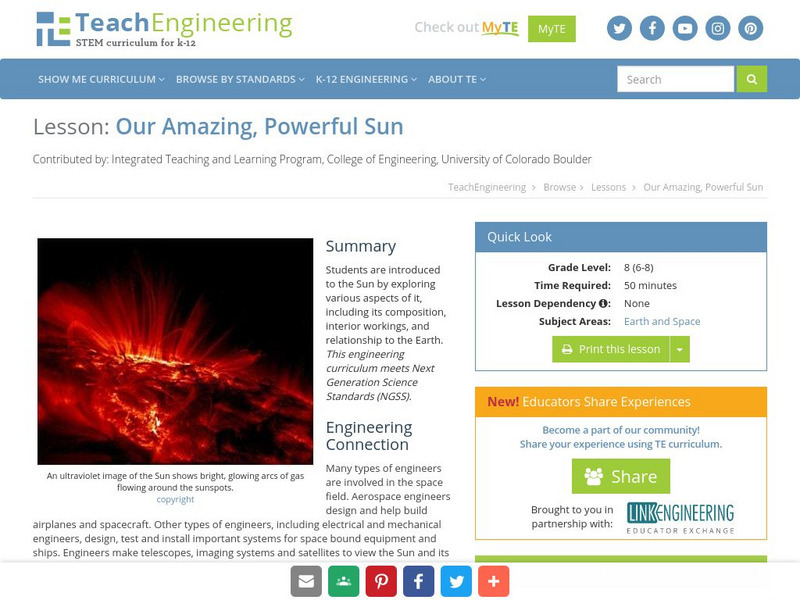TeachEngineering
Teach Engineering: The Science of Swinging
Young scholars learn what a pendulum is and how it works in the context of amusement park rides. While exploring the physics of pendulums, they are also introduced to Newton's first law of motion - about continuous motion and inertia.
TeachEngineering
Teach Engineering: Solar Angles and Tracking Systems
Students learn about the daily and annual cycles of solar angles used in power calculations to maximize photovoltaic power generation. They gain an overview of solar tracking systems that improve PV panel efficiency by following the sun...
TeachEngineering
Teach Engineering: The Temperature Effect
Students explore how the efficiency of a solar photovoltaic (PV) panel is affected by the ambient temperature. They learn how engineers predict the power output of a PV panel at different temperatures and examine some real-world...
TeachEngineering
Teach Engineering: Maximum Power Point
Students learn how to find the maximum power point (MPP) of a photovoltaic (PV) panel in order to optimize its efficiency at creating solar power. They also learn about real-world applications and technologies that use this technique, as...
TeachEngineering
Teach Engineering: Concentrated Solar Power
Students learn how the total solar irradiance hitting a photovoltaic (PV) panel can be increased through the use of a concentrating device, such as a reflector or lens. This is the final lesson in the Photovoltaic Efficiency unit and is...
TeachEngineering
Teach Engineering: Making & Breaking: The Rock Cycle
Students learn the components of the rock cycle and how rocks can change over time under the influence of weathering, erosion, pressure and heat. They learn about geotechnical engineering and the role these engineers play in the...
TeachEngineering
Teach Engineering: How Mountains Are Formed
Students investigate how mountains are formed. Concepts include the composition and structure of the Earth's tectonic plates and tectonic plate boundaries, with an emphasis on plate convergence as it relates to mountain formation....
TeachEngineering
Teach Engineering: Soil Investigations
Students learn the basics about soil, including its formation, characteristics and importance. They are also introduced to soil profiles and how engineers conduct site investigations to learn about soil quality for development,...
TeachEngineering
Teach Engineering: Ecology at Work
Students learn how rooftop gardens help the environment and the lives of people, especially in urban areas. They gain an understanding of how plants reduce the urban heat island effect, improve air quality, provide agriculture space,...
TeachEngineering
Teach Engineering: Just Plane Simple
This lesson introduces students to three of the six simple machines used by many engineers. These machines include the inclined plane, the wedge and the screw. In general, engineers use the inclined plane to lift heavy loads, the wedge...
TeachEngineering
Teach Engineering: Levers That Lift
This lesson plan introduces students to three of the six simple machines used by many engineers: the lever, the pulley, and the wheel-and-axle. In general, engineers use the lever to magnify the force applied to an object, the pulley to...
TeachEngineering
Teach Engineering: Not So Simple
Students expand upon their understanding of simple machines with an introduction to compound machines. A compound machine - a combination of two or more simple machines - can affect work more than its individual components. Engineers who...
TeachEngineering
Teach Engineering: Solar Power
Students learn about solar energy and how to calculate the amount of solar energy available at a given location and time of day on Earth. The importance of determining incoming solar energy for solar devices is discussed.
TeachEngineering
Teach Engineering: Making Music
In this instructional activity, learners learn about sound. Girls and boys are introduced to the concept of frequency and how it applies to musical sounds.
TeachEngineering
Teach Engineering: To Absorb or Reflect, That Is the Question
This is the last of five sound lessons, and it introduces acoustics as the science of studying and controlling sound. Learners learn how different materials reflect and absorb sound.
TeachEngineering
Teach Engineering: Pictures Please: Traveling Light
In this instructional activity, students learn that light travels in a straight line from a light source and that ray diagrams help us understand how an image will be created by a lens. In the accompanying activity, students explore the...
TeachEngineering
Teach Engineering: Space Travel
Students are introduced to the historical motivation for space exploration. They learn about the International Space Station as an example of space travel innovation and are introduced to new and futuristic ideas that space engineers are...
TeachEngineering
Teach Engineering: Life on the Moon
Students learn about the physical properties of the Moon. They compare these to the properties of the Earth to determine how life would be different for people living on the Moon. Using their understanding of these differences, they...
TeachEngineering
Teach Engineering: Asteroids
Students learn some basic facts about asteroids in our solar system, mainly about the size of asteroids and how that relates to the potential danger of an asteroid colliding with the Earth. Students are briefly introduced to the...
TeachEngineering
Teach Engineering: Our Amazing, Powerful Sun
Middle schoolers are introduced to the Sun by exploring various aspects of it, including its composition, interior workings, and relationship to the Earth.
TeachEngineering
Teach Engineering: Abdominal Cavity and Laparoscopic Surgery
For students interested in studying biomechanical engineering, especially in the field of surgery, this lesson serves as an anatomy and physiology primer of the abdominopelvic cavity. Students are introduced to the abdominopelvic...
TeachEngineering
Teach Engineering: Mechanics of Elastic Solids
After conducting the associated activity, young scholars are introduced to the material behavior of elastic solids. Engineering stress and strain are defined and their importance in designing devices and systems is explained. How...
TeachEngineering
Teach Engineering: Viscous Fluids
Students are introduced to the similarities and differences in the behaviors of elastic solids and viscous fluids. Several types of fluid behaviors are described--Bingham plastic, Newtonian, shear thinning and shear thickening--along...
TeachEngineering
Teach Engineering: Viscoelasticity
Students are introduced to the concept of viscoelasticity and some of the material behaviors of viscoelastic materials, including strain rate dependence, stress relaxation, creep, hysteresis and preconditioning. Viscoelastic material...










